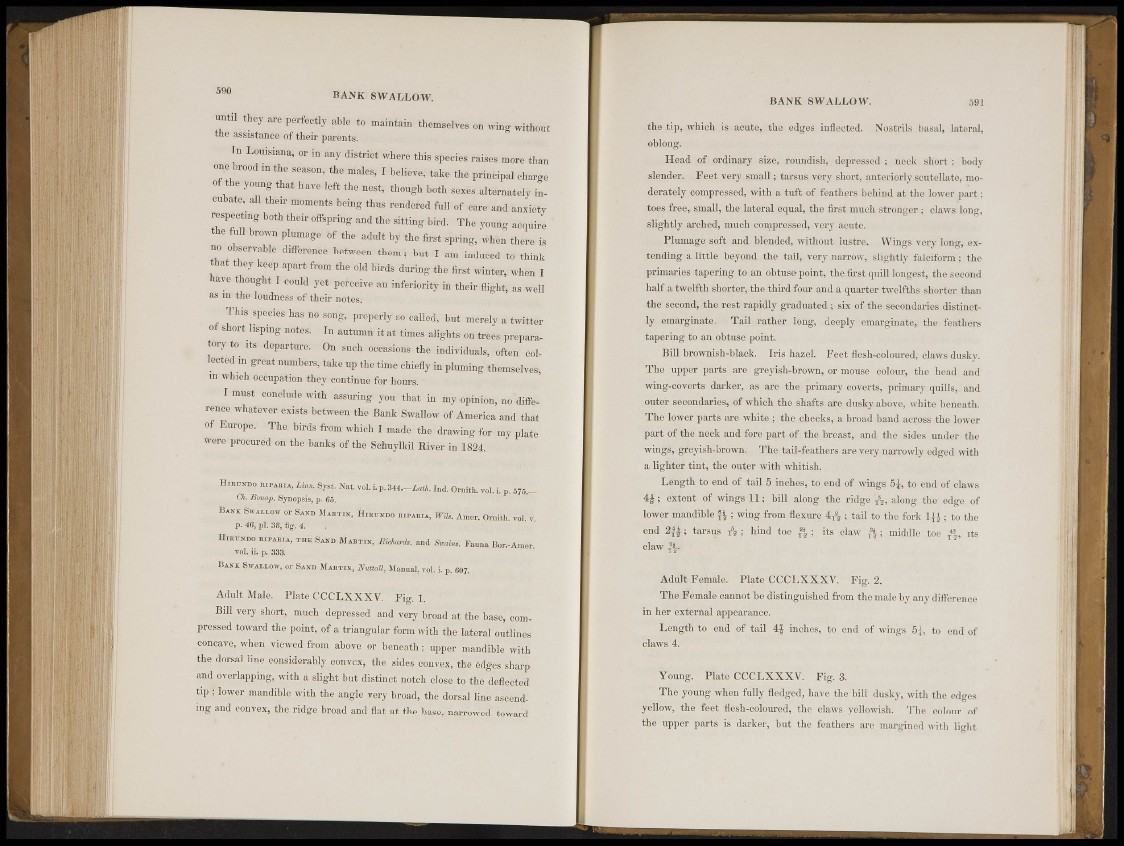
590 BANK SWALLOW.
m m they aie-pBTfe^ ablate mttntaia themMvéson wing wiifcmt
the assistance of their parents.
B l « s i a n a > « te any district where this speci f r a f e H H
on,e brood in the season, t f c e ^ I tafe to principal dftrge
of the young that have loft the-nost, though both sexi« alternate» 1
eubate, all their ,n„mt!nte being thus rendered full „f „,ro and anxietv
^espeoting both their offspring and the sitting bird. The youtig a S q ^ '
the full brown plumage M the H bji the tet spring, when thereis
• • SgM M & , !lm HH § gj§
that m r keep apart from the old birds during the fesr«*^«»* I
M 1 e o û M J « inferiority i„ their flight, as well
a« ill the loudnessT.f their notes. '
Thisjspeeies has -nosong, proprfy'so. caJM, tat merely a twitter
of short lisping «te«. In autant it.-rt fin,,¡.raJSghts xm trees^reparat
®y to- its departure. On snel, ,,¡»,,.<¡,7® the imliiiduals, often ^
Imtf m groat numbers; take up the .time chiefivin pluming themselves-,
in which occupation tliey continue for hours.
H B °<®°Me with cur ing y«,u H H my opinion* WÊÊÊ
rence whatef * exists between t f e Bank Swallow of America and tbtft
of Buibfte, The, birds frto which I made the dra*bgrfor my,plate
*ere procurai or. the hanks of the Schuylkil Hiver in LS2f
H . » y IUPA.UA,£i„..Syst îîatvolip S ^ -W' i a d oJ»£"S. p 575.-_
Ch. Boncup. Synopsis, p. 65.
IÎA.VK ¿WAI'Ioiv 0r SAM, ) !»«„ , Hi RI:* no H I ÏAÎ IA, WÊÊÊÊÊÊÊÊÊ " ' p ie, pi gSfflgJ6!i s ^ W
H*"*«*»»«*, *• * » * « A A « . IWBoi-Amei
v'oL ii..,p. 333; >
. HAS. 8V.MJ.OW, or SATO H u x i ^ & g Ç j p , Jlamal!, vo!. i.;f. 607.
Adult Male, l'iate COCJ.XXXV. " Fig. 1.
B i | | e r y short, much depressed ant « ç f i s l d at the base, compressed
toward the point,, of a triangular form with the lateral outlines
concave,, when viewed from above or'baffiath; upper mandible with
the dorsal line considerably ¿onvex, the sides convex, the edges sharp
and overlapping,, with a slight but distort potch close ,to the deflected
tip ; lower mandible with the angle verj broad, the dorsfl line ascending
and convex, the ridge broat and flat at the ba.se, narrowed toward
BANK SWALLOW. 591
the tip, which is acute, the edges inflected. Nostrils, f basal, lateral,
oblong.
Head of ordinary size, roundish, depressed ? neck short ; body
slender. . Feet very small; tarsus very short, anteriorly scutellate, m0>-
derajely compressed, with a tuft, of feathers behind at the lower part;
toes free,, small, the lateral equal, the first much stronger ; claws long,
.slightly arched, much compressed, very acute..
Plumage soft and blended, without lustre. Wings very long, extending
a. little beyond the tail, very narrow, slightly falciform; the
primaries tapering to an obtuse point, the first quill longest, the second
half a; twelfth shorter, the, third four and a quarter twelfths shorter than
the second, the rest rapidly graduatedsix of the secondaries distinctly
emarginate, Tail' rather fting, deeply emarginate,. the feathers
tapering to an obtuse5 point.
Bin brownish-black. Iris hazeli , Feet flesh-coloured, claws dusky.
The upper parts are greyish-brown, or mouse eohnir, the head and
wing-coverts dark®; as: are the. primary coverts, primary quills, and
outer secondaries, of which the ,shafts aire dusky above, white beneath.
The lower parts are whiter-, the cheeks, it broad hand aeioss the lower
part of the nesjf and fore part of the breast, and the sides under the
wings, greyish-brown. The tail-feathers are very narrowly edged with
a lighter tint, the outer with whitish,
Length to end of tail 5 inches, to end of wings 5i, to end of claws
4 | ; extent of wings 11; bill along the ridgealong the1 edge of
lower mandible f j , ; wing from flexure 4 f t ; tail to the fork l j ; ; to the
end 2|> ; tarsus A ; hind toe its claw middle toe t«, its
claw ||>-
Adult l-'emalt? l'iate CCCI.XXXV. Fig. 2.
The Female cannot be distinguished from the male by any difference
in her external appearance.
Length to end of tail 4f inches, to end of wings 51, to end of
claws 4.
Young. ' Mate CCCI.XXXV. Fig. 3.
The young when folly fledged, have the bill dusky, with the edges
yellow, the feet flesh-coloured, the claws yellowish. The colour of
the upper parts is darker, but the feathers are margined with light